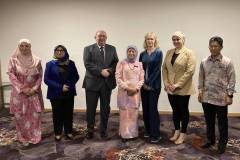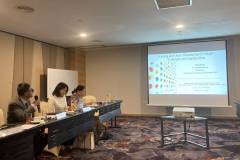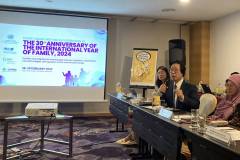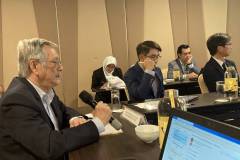
CONCEPT NOTE
Migration and Urbanization
Migration represents one of the most important social phenomena of the late twentieth and early twenty-first centuries. International migration and internal migration are two fundamental categories that encompass the movement of individuals across geographical boundaries. While both terms refer to the relocation of people, they differ in the scale and nature of the migration process.
International migration involves the movement of individuals across national borders, resulting in a change in citizenship. This type of migration can be motivated by a variety of factors, including economic opportunities, political stability, family reunification, or the pursuit of educational or professional advancements. International migration can be further categorized as voluntary or involuntary. Voluntary migration occurs when individuals choose to relocate for personal reasons, while involuntary migration is often the result of conflict, persecution, or natural disasters.
Internal migration, on the other hand, refers to the movement of individuals within the boundaries of a single country. This type of migration can be driven by factors such as rural-urban migration, urban sprawl, or the pursuit of better employment opportunities or educational facilities. Internal migration can also be influenced by government policies, regional economic disparities, and individual aspirations for a better quality of life.
The distinction between international and internal migration is significant for understanding the demographic patterns, economic dynamics, and social implications of population movements. International migration has a profound impact on both sending and receiving countries, influencing labor markets, economic development, and cultural exchange. Internal migration, while primarily affecting the distribution of population within a country, can also lead to urban growth, regional disparities, and the transformation of rural and urban landscapes.
Closely linked with migration is the rapid urbanization that is occurring in many parts of the world and is changing family structures. As migrants leave rural areas seeking opportunities in cities, urban areas are growing at an exponential pace. (1)
Both trends have a profound impact on family life, family relationships, and family practices:
Changes in family structures, such as smaller households and fewer multigenerational families — as people move to cities or other countries, they may leave behind extended family members and rely more on nuclear families or chosen families for support;
Cities can provide new economic opportunities for families, such as higher-paying jobs or access to better education and healthcare, but they can also create economic challenges, such as higher living costs or difficulty finding work in the new location, overcrowded cities, slums, burden on infrastructure, etc.
Disruption of social support networks for families, as they may be separated from extended family members, friends, and other support systems, while they may build new networks in the new location, such as through work or community organizations.
Adaptation to new cultural norms and practices, which can be challenging, like learning a new language, adjusting to new food and customs, and navigating new social hierarchies.
The impact can be especially significant for the most vulnerable as children, older persons and persons with disability, particularly if they are forced to move due to conflict or displacement, as they may experience trauma, disrupted education, lack of mobility and other challenges that can affect their well-being and development.
Young people can also be heavily affected in terms of employment, housing and family formation. In that sense, it is now more important than ever to bear in mind that integration is an investment. (4-2)
Asia has been experiencing rapid urbanization and migration in recent decades. This has led to significant changes in the social, economic, and cultural landscape of the region. Migration from Asia to Northern America and Europe drove much of the increase in the number of Asian migrants outside the region, reaching a total of more than 46 million extra-regional migrants in 2020. (5-3)
Many migrant workers leave their families behind and only return home for brief visits. This has led to the development of new family structures and relationships, with grandparents often taking on a more prominent role in the upbringing of children.
In reply to these challenges, one of the biggest challenges faced by Asian cities is the need to provide adequate infrastructure and services to accommodate the growing urban population. This includes building new housing, transportation systems, and social services such as healthcare and education.
Policies and programs that support migration and well-planned and well-managed sustainable urbanization are closely related to the successful realization of the United Nations Agenda 2030, as localized by the New Urban Agenda. SDG 11 emphasizes the need for inclusive, safe, resilient, and sustainable cities and communities. Ensuring that families have access to adequate housing, basic services, and infrastructure, and that they are not left behind in the process of urbanization, is crucial for achieving it, and that is the policy framework of the New Urban Agenda.
Overall, the challenges posed by urbanization and migration in Asia are complex and require a coordinated effort by governments, civil society organizations, and individuals to address them effectively.
Interlinkages
Migration and urbanization are closely linked to climate change but the interlinkages between these megatrends have not been well researched or explored. It is imperative to assess the impact of climate change on families as a driver of both migration and urbanization. As the planet warms, extreme weather events such as droughts, floods, and wildfires are becoming more frequent and severe. These events are displacing people from their homes and livelihoods, forcing them to migrate in search of safety and opportunity. In addition, climate change is also leading to sea level rise, which is inundating coastal communities and forcing people to relocate to higher ground.
Urbanization is also being driven by climate change. As people migrate from rural areas to cities, they are putting a strain on urban infrastructure and resources. This can lead to problems such as overcrowding, slums, and poverty. Thus, the impact of urbanization and migration makes cities more vulnerable to the impacts of climate change with rapid urban growth, increased pollution, deforestation, loss of biodiversity, and extreme weather events.
Unsustainable urbanization exacerbates climate change and its negative impacts on families while sustainable urbanization is imperative for managing climate change and technological solutions are of major importance. In this regard, adaptation technologies have the potential to reduce the impact of climate change on families and contribute to family well-being.
New technologies have played a significant role in shaping family dynamics regarding the challenges faced by migrants in urban environments. The rise of social media platforms, video conferencing tools, messaging apps and online remittance services, and other digital platforms has made it easier for families to stay connected despite physical distance. However, it has also introduced new challenges, such as the potential for social isolation and the impact of technology on family relationships.
Migration and urbanization have also impacted demographics. Family reunification policies have an impact on family relations, as they establish the terms under which migrants and their family members are allowed to enter and settle in destination countries. There is a close relationship between policies, migratory trajectories and transnational families, with such regulations being assessed by families when a member wishes to migrate and make decisions about migration. These policies may facilitate or restrict migratory flows and the conditions under which they occur. Thus, they can either contribute to family well-being or expose families to the processes of exclusion and risk. (2-4)
The United Nations Division for Inclusive Social Development “supports the New Urban Agenda and advocates for including an intergenerational perspective in designing family-friendly cities. Children and youth need secure urban environments to go to school safely and access safe playgrounds and recreation opportunities, including sports facilities. All generations, including older persons and young people, as well as persons with disabilities and families with children, need accessible means of transportation and mobility. New intergenerational approaches to urban planning have been gaining ground, with city planners, backed by local communities, designing intergenerational sites, including schools and retirement homes built close to each other, so that generations can interact and feel part of a larger community.” (3-5)
EXPERTS
Prof. Narimah Awin, UNFPA Malaysia Country Office, Malaysia
Mrs. Lishuang Chen, China Great Wall Society, China
Prof. Meejung Chin, Seoul National University, South Korea
Prof. Ki-Soo Eun, Seoul National University, South Korea
Prof. Rumaya Juhari, University Putra Malaysia, Malaysia
Assoc. Prof. Jong-ik Lee, Blue Tree Foundation, South Korea
Assoc. Prof. Tey Nai Peng, University of Malaya, Malaysia
Assoc. Prof. Bhubate Samutachak, Mahidol University, Thailand
Prof. Sunil Babu Shrestha, Nepal Academy of Science and Technology, Nepal
Prof. Rokuro Tabuchi, Sophia University, Japan
SESSIONS
1. Interlinkages between migration, urbanization, new technologies, demographic trends and climate change.
2. Socio-economic challenges for migrant families.
3. Transnational migration and displacement.
4. Housing and Urban Development.
5. New technologies and climate change: challenges and opportunities.
DESIRED OUTCOMES
1. Underline the impact of migration on transforming family structures.
2. Highlight the New Urban Agenda and explore ways to achieve inclusive, safe, resilient and sustainable cities.
3. Analyze strategies for optimizing the benefits of technology while minimizing its drawbacks on family relationships.
4. Explore the policy lessons learned from Asia that can be applied globally, and the potential contributions of global experiences to the Asian context.
5. Explore the interlinkages between migration, urbanization, new technologies and climate change.
REFERENCES
(2) OECD, What is the impact of the COVID-19 pandemic on immigrants and their children? (2020)
(3) IOM, World Migration Report 2022
BACKGROUND DOCUMENTS
Resolution of the UN General Assembly
Report of the Secretary-General
UN Website
EGM Cairo (June 2022)
EGM South Africa (January 2023)
GALLERY

The International Forum on Families and Global Megatrends, organized after the Expert Group Meeting, aimed to serve as the best platform for the Ministry of Women, Family and Community Development (KPWKM) to emulate the practices of foreign countries in facing the challenges of global megatrends that affect family institutions.
Minister Datuk Seri Nancy Shukri said the forum, which was held for the first time in Malaysia, brought together experts from several countries including South Korea, Thailand, Japan, India, China and Nepal covering various fields such as demography, family, climate change, and reproductive health.
“I believe programmes like this need to be held regularly because they encourage us to gain ideas and learn from others about the topics discussed (the impact of global megatrends on family institutions),” he told reporters after officiating the closing ceremony of the forum here yesterday.
The International Forum on Families and Global Megatrends was held in conjunction with the 30th International Day of Families, organised by the United Nations, the Department of Economic and Social Affairs, the International Federation for Family Development (IFFD) and the Doha International Family Institute (DIFI).
Commenting on global megatrends such as migration, climate change, urbanisation, technological advancements and demographic transitions, Nancy said they significantly influenced and impacted family institutions worldwide, including in Malaysia.
She noted that these changes required adjustments in caregiving arrangements, continuously updated financial planning, and guidance for families to adapt and play their roles effectively.
PROGRAMME
Preparations and Celebration for the Thirtieth
Anniversary Of The International Year of the Family
Renata Kaczmarska
Focal Point on the Family
Division for Inclusive Social Development (DISD)
United Nations Department of Economic and Social Affairs (DESA)
Civil Society Declaration for the Anniversary
Ignacio Socias
Director of International Relations
International Federation for Family Development
Interactive Panel
Demographic Trends and Families
Ki-Soo Eun
Professor of Sociology and Demography
Director, Center for Transnational Migration and Social Inclusion
Graduate School of International Studies,
Seoul National University
Climate Change and Families
Muhammad Ridzwan bin Ali
Climate Change Division
Ministry of Energy and Natural Resources
Malaysia
Technological Change and Families
Khalid Al Naama
Director of Family Policy and Research
Doha International Family Institute, Qatar
Q & A session
Closing Speech
YB Dato’ Sri Hajah Nancy Shukri
Minister of Women, Family and Community Development
Malaysia



































